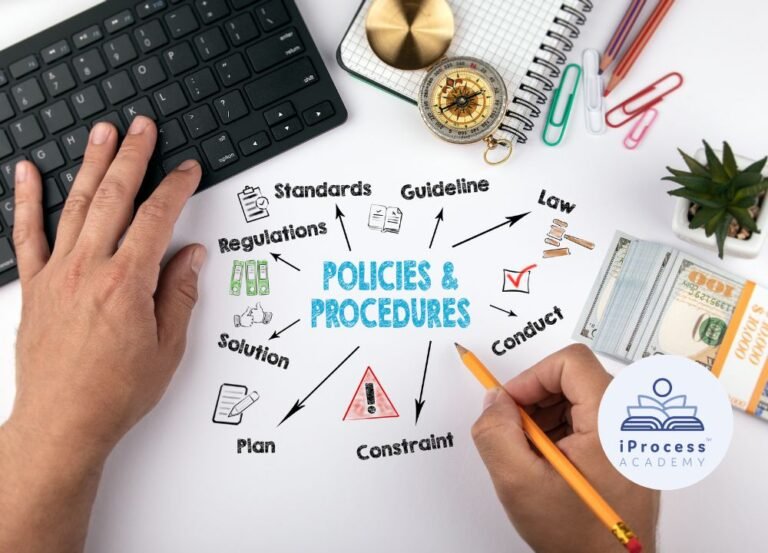The five most common mistakes in the preparation of work procedures
In this article, we will look at the most common mistakes in the preparation of work procedures. Incorrectly prepared procedures raise many questions. They become incomplete documents, as a result of which the responsibilities of employees and the tasks performed may be inappropriately distributed. An incorrectly drafted procedure becomes a document that does not perform its function and may therefore be unusable because it loses its meaning and usefulness.
How to prepare for the procedure correctly is explained in this article.
An incorrectly designed procedure is:
- Unclear;
- There is a lack of logic between points, or even in one and the same point;
- It is not clear how to apply the described point or section in practice;
- General attitudes prevail and there is a lack of responsible persons (positions);
- There is a lack of uniform criteria or definitions.
Let’s take a closer look at the most common mistakes.
1. Unclear initial information
The procedure must be designed so that it is understood by any new employee and clear to those in charge how to divide work and tasks.
The name of the procedure must be clear and specific.
For example, do not use “Procurement procedure” but “Procedure for buying goods online from suppliers.” The clearer the name, the clearer the procedure’s content will be.
There are cases when a lot of information is stored in one procedure. For example, the sales procedure describes:
- how to sell directly to the customer;
- how to sell online;
- how to sell a product on debt if there is no balance at the point of sale;
- how to accept the return of the item.
Three tips for a clear work procedure
In such cases, separate work procedures must be drawn up, and one large procedure must be broken up. I will explain why it is worth doing this:
The purpose of the procedure must be defined in one clear sentence.
For example, “Ensure that orders for goods are fulfilled on time, in accordance with contracts and cost controls.”
The most common mistake in the preparation of procedures: too many theoretical phrases, no practical applicability. A document of this kind loses its meaning because it does not answer the questions: WHO, HOW, WHEN, IN WHAT WAY must perform the task and on what basis documents or instructions.
2. The course of activities is inconsistent and incomplete
Each step described in the procedure must consist of: 1 action, 1 responsible person, 1 specific result.
Formula for each point:
What? + What does it do? + When? + How? + Result/ Record
The most common error in the preparation of procedures: the action is described in a general provision. It is not specified what position should perform the action, nor when, nor how. For example, in the document of the procedure, the entry “checks on balances” will raise a lot of questions: how and when to check and who should check.
If the document is unclear, then the person in charge of the department or department is engaged in the activity because it becomes unclear to whom it is necessary to delegate this task. Another case is that when an organisation is large and has many departments, then each department will perform a balance check differently, as the person in charge individually understands each department. In this case, a large organisation will not be standardised.
3. Thought leaps and logical holes dominate
The thought jumps and logical holes that occur in the document make the procedure inconsistent and unclear.
What do thought jumps and lack of logical sequence look like:
- In one item, one person is responsible for the same action, in the next item, another person is responsible.
- It is not clear how one responsible person transmits information to the next responsible person. For example, one person receives important information and the other person performs. However, it is not clear how the second person learns about the same important information.
- No conjunctions are used in the paragraph describing the action performed, e.g., “then”, “upon receipt”, “when approved”, or “when the document is prepared”.
Logical holes in the document can promote miscommunication between employees and outbursts of negative emotions.
4. No links to attachments or forms
Sometimes, procedural documents do not contain references to annexes or forms. In such cases, employees have to search for document forms themselves, thus wasting time. In other cases, each employee will understand differently what forms need to be filled out to complete the steps provided for in the procedure. Such an incomplete document will encourage miscommunication between employees and the possibility of errors.
5. Lack of precision and clarity in concepts
A common mistake in the preparation of procedures is that the person who drafted the document “knows” what he means by describing the action. Another frequently used phrase is “it goes without saying“. The essence of the document is to describe clearly and in detail, in order to delete the words “it goes without saying” or “I know” from the terminology used in the organisation. Such vague procedures will promote different understandings of individuals and, again, encourage miscommunications. For example, in a document, the entry “the product may pose a threat to human health” is unclear. Further, the procedure document does not specify “what is a threat to health”, “in which cases a threat to human health may occur”, “how the product must look in order to understand that it is a threat to health”, etc.
3 questions for auditing correctness
In order to prepare a document that is accurate and complete, it is appropriate to answer the following three questions:
- Does each step have a clearly named executor?
- Does each action have a logically clear context (cause, time, condition)?
- Would a reader, even if he were not a specialist in that particular work, be able to perform actions under this procedure without further explanation and without asking additional questions?
If at least one answer is “no”, then the procedure must be rewritten.
There are cases where different concepts are named in one and the same paragraph, where even at the beginning of the document there is no definition of terms. For example, in one and the same paragraph, the resident, the patient, the customer are mentioned. Confusion arises when reading a paragraph, since it becomes unclear whether it is one and the same person or whether it is three different persons.
Another example: one section contains the terms “supplier” and “wholesale company”. Again, it becomes unclear whether it is one and the same company or whether it is two different companies. Especially since the terms and definitions at the beginning of the document do not include the terms and definitions of either “supplier” or “wholesale company”.
Conclusions
We have described five most common mistakes that should be taken into account when preparing procedures. Procedures can be prepared by employees in the organisation. It is not necessary to hire consultants, but it is important to know the progress and rules of preparing the document. To this end, the staff preparing the procedures must be trained on how to prepare the procedures correctly. There may be a separate document prepared in the organisation or even a procedure on how to prepare the procedure correctly.
It is important to know that the company’s internal procedures must approve the definitions of terms and concepts and their abbreviations.
Only an approved dictionary of terms must be used to prepare procedures. In turn, the organisation’s employees must be introduced and trained to use only approved deadlines.
This article is the intellectual property of the author. You must provide a reference to the article’s source and name the author when citing any passage from this article.
You can learn more about the author’s competence, Dr. Diana Satkutė, here.




